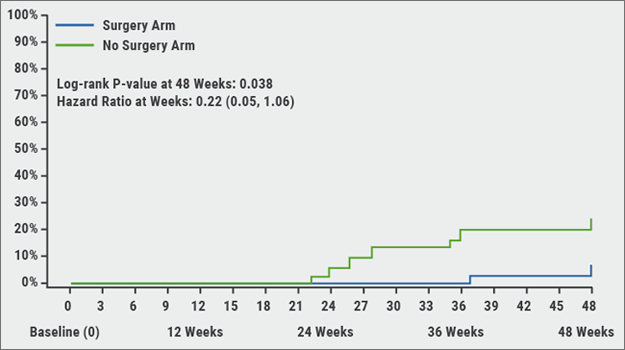Endoscopic treatments
For chronic bronchitis patients, the evidence for treatment options is not conclusive or lacking [22]. “So, it is good to look at other opportunities for the treatment of these patients”, mentioned Dr Klooster. “There are some new non-pharmacological therapies, but they are still under investigation.” Cryotherapy uses nitrogen gas which creates extremely cold temperatures to destroy diseased tissue. The use of a liquid nitrogen metered cryospray is intended to destroy the goblet cells and also the submucosal glands. These cell types are present in the central airways up to the segmental level in the airways. Cryotherapy results in a non-scarring healing effect. In this procedure, the application of liquid nitrogen at -196°C with a pre-determined dose results in rapid endobronchial tissue freezing. The aim is to cryoablate abnormal surface epithelium with overgrown mucin producing goblet cells and adjacent submucosa up to a depth of 0.5 mm. Furthermore, this procedure facilitates normal bronchial epithelium regrowth with ciliated respiratory epithelial cells that will facilitate removal of mucins from the bronchial airways. Finally, the resulting reduction in chronic inflammation leads to increased airway elasticity and diameter. The treatment is well tolerated and is associated with minimal device-related (serious) AEs. The durability of the treatment is not yet known, so “we do not know whether exacerbations will be reduced”, added Dr Klooster. “We only know that, in one study, it improved respiratory symptoms and quality of life.”
Bronchial rheoplasty
Another treatment which targets the airway epithelium is aimed to restore the goblet cells and submucosal glands and is called bronchial rheoplasty pulsed electric field airway ablation. In this intervention, high frequency short duration energy is delivered to the airway epithelium and submucosal tissue layers, which induces cell death via apoptosis. A pulse electric field is specifically designed to target the end effectors of the goblet cells and submucosal glands. The epithelium regenerates as healthy tissue with fewer goblet cells, hopefully resulting in less mucus production. The Gala Airway Treatment System (RheOxTM™) was designed to ablate abnormal mucus glands of the epithelium, thereby reducing mucus production and improving symptoms and outcomes in chronic bronchitis patients. The high frequency energy is delivered through the bronchoscope. The FDA gave approval to conduct an early feasibility study in the US, to examine the safety of the RheOxTM™ system in subjects with chronic bronchitis. Preliminary results showed significant improvement in quality of life.
Lung denervation
The final subject Dr Klooster discussed was targeted lung denervation, which is intended for patients with COPD, so not with chronic bronchitis. It is a single bilateral procedure which takes approximately 1 hour and is performed under general anaesthesia. “We have to use fluoroscopy”, she added, “to look at the electrode. Furthermore, an oesophageal balloon is used for real-time localisation of the oesophagus to prevent gastric side-effects.” The first-in-human studies showed that targeted lung denervation is safe and feasible.
- Vestbo J, et al. Am J Respir Crit Care Med. 1996;153:1530-5.
- Kim V, Criner GJ. Am J Respir Crit Care Med. 2013;187:228-37.
- Lange P, et al. Thorax. 1990;45:579-85.
Posted on
Previous Article
« Brain metastases, lung cancer and interstitial lung disease Next Article
ICS: to use or not to use? »
« Brain metastases, lung cancer and interstitial lung disease Next Article
ICS: to use or not to use? »
Table of Contents: ERS 2018
Featured articles
Letter from The Editor
[Long Read] Current Look on Asthma
COPD: Triple Therapy, MABA and Antibiotics
Landmark triple therapy trials
ICS: to use or not to use?
MABA, and novel LAMA
Macrolide antibiotics and trial with azithromycin
Current Look on Asthma
[Long Read] Current Look on Asthma
Endoscopic Solutions
Endoscopic treatment of emphysema
Endoscopic treatment of asthma
Endoscopic treatment of chronic bronchitis
PAH
Balloon pulmonary angioplasty for CTEPH
New therapeutic targets: moving form pre-clinical data to phase 2 studies
IPF
Gastroesophageal reflux, IPF and lessons learned
Oncology
ALK inhibition, guidelines, liquid biopsies, and immunotherapy
Brain metastases, lung cancer and interstitial lung disease
Related Articles

November 7, 2018
ICS: to use or not to use?

November 7, 2018
Gastroesophageal reflux, IPF and lessons learned
November 7, 2018
IPF introduction and Pentraxin-2
© 2024 Medicom Medical Publishers. All rights reserved. Terms and Conditions | Privacy Policy
HEAD OFFICE
Laarderhoogtweg 25
1101 EB Amsterdam
The Netherlands
T: +31 85 4012 560
E: publishers@medicom-publishers.com

